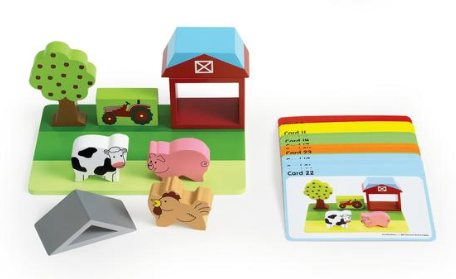 |
| 3D Spatial Relations Activity Set |
This is a fun activity to teach spatial reasoning. The kids like the farm theme, the pieces are solid wood, and the pattern cards are easy to read.
The pattern cards increase in difficulty, including more pieces and stacking as you go. The colored borders on the cards indicate difficulty, so they are easy to sort quickly.
The green base is a flat piece of wood, not grooved like the Excellerations Spatial Relations Playset. Establish terms for the three green strips on the base to make sure you are both on the same page when talking about positioning pieces. Such as dark green stripe or back, middle or medium green stripe and light green stripe, yellow or front. I found it easier to say front, middle and back because some kids were confused when I tried to describe the strips by color gradient.
The wood pieces are chunky and easy to handle. The wood piece with the tractor has a fence painted on the other side. Sometimes a piece will take up 2 spaces (barn turned sideways) or a portion of it will be hidden when an animal is entering or leaving the barn.
 |
Pattern cards for 3D Spatial Relations Activity Set. |
For more of this type of activity, see my post on What's in Your Therapy Box? Pattern Blocks Edition.
Try this:
Try this:
- Start by giving free time to play with the blocks so the individual can see how they feel, what they look like from different angles and how they stack.
- Use consistent positional language such as front, middle, back, in front of, behind, next to, under, on top of.
- Let the child make up his own picture and describe it to you in positional terms.
- Ask questions such as 1) who is on top of the barn?; 2) Who is behind the cow?; 3) Where is the tractor?
- Prop the pattern card at a distance and see if the individual can look up and then remember the piece needed, orientation, and placement when he looks down to create the model.
- Practice turning the animal in-hand for correct orientation.
- Give the beginner only one piece or only the pieces needed for one stripe at a time if he is struggling.
- Work consistently from the back to the front, one level at a time. It's harder to place pieces behind pieces that are already on the base.
- Ask the child to find the mistake if one is made before jumping in to help. Can he compare the 3D model to the 2D card, find the error and correct it?
- Place all the pieces needed for a puzzle and the puzzle card in front of the child and remove the rest if you think the child will be overwhelmed or won't be able to find them in the group.
- Leave all the pieces in a pile and ask the child to find each piece in the group as he needs it.
- Work on visual discrimination, spatial relations, visual closure, figure ground, visual memory, eye-hand coordination, executive functioning skills, crossing midline, manual dexterity, in-hand manipulation, process skills, play and leisure exploration and participation

No comments:
Post a Comment
Thank you for taking the time to comment.